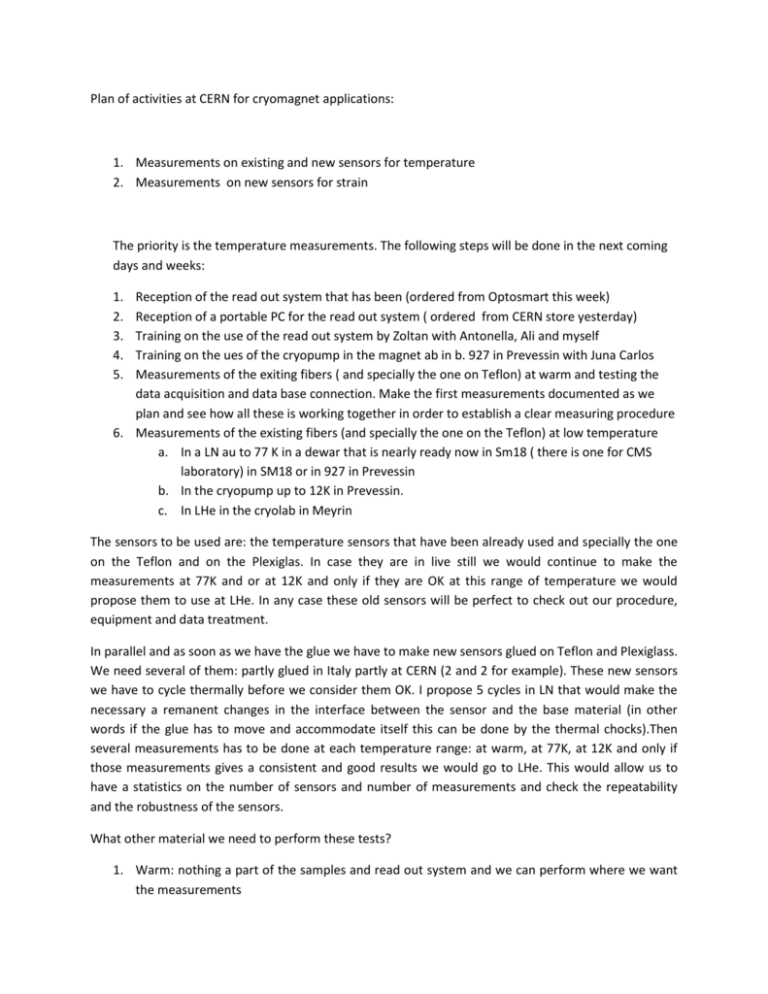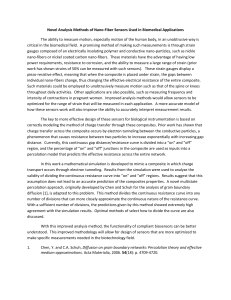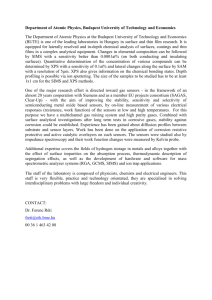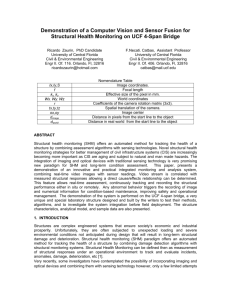Plan_of_activities_at_CERN_for_cryomagnet_applications
advertisement

Plan of activities at CERN for cryomagnet applications: 1. Measurements on existing and new sensors for temperature 2. Measurements on new sensors for strain The priority is the temperature measurements. The following steps will be done in the next coming days and weeks: 1. 2. 3. 4. 5. Reception of the read out system that has been (ordered from Optosmart this week) Reception of a portable PC for the read out system ( ordered from CERN store yesterday) Training on the use of the read out system by Zoltan with Antonella, Ali and myself Training on the ues of the cryopump in the magnet ab in b. 927 in Prevessin with Juna Carlos Measurements of the exiting fibers ( and specially the one on Teflon) at warm and testing the data acquisition and data base connection. Make the first measurements documented as we plan and see how all these is working together in order to establish a clear measuring procedure 6. Measurements of the existing fibers (and specially the one on the Teflon) at low temperature a. In a LN au to 77 K in a dewar that is nearly ready now in Sm18 ( there is one for CMS laboratory) in SM18 or in 927 in Prevessin b. In the cryopump up to 12K in Prevessin. c. In LHe in the cryolab in Meyrin The sensors to be used are: the temperature sensors that have been already used and specially the one on the Teflon and on the Plexiglas. In case they are in live still we would continue to make the measurements at 77K and or at 12K and only if they are OK at this range of temperature we would propose them to use at LHe. In any case these old sensors will be perfect to check out our procedure, equipment and data treatment. In parallel and as soon as we have the glue we have to make new sensors glued on Teflon and Plexiglass. We need several of them: partly glued in Italy partly at CERN (2 and 2 for example). These new sensors we have to cycle thermally before we consider them OK. I propose 5 cycles in LN that would make the necessary a remanent changes in the interface between the sensor and the base material (in other words if the glue has to move and accommodate itself this can be done by the thermal chocks).Then several measurements has to be done at each temperature range: at warm, at 77K, at 12K and only if those measurements gives a consistent and good results we would go to LHe. This would allow us to have a statistics on the number of sensors and number of measurements and check the repeatability and the robustness of the sensors. What other material we need to perform these tests? 1. Warm: nothing a part of the samples and read out system and we can perform where we want the measurements 2. @ 77 K : we need also a dewar ( is ready) and the LN. the measurements should be done in a zone where this is possible: ex. SM18, 927 or CMS when this will be clarified how to get LN there. There are two type of measuring procedure: a. For old sensor having been thermally chocked we have to cool down the sensors very slowly and handle them carefully as they can be easily damaged (we used not appropriate glue and they well mounted -dismounted several times). b. For new sensors that need to be thermal cycled a real chock has to be done on the PREVIOUSLYY WELL GLUED AND MECAHNICALLY SUPPORTED SAMPLES! 3. @ 12 K we need the cryo pump and learn how to use it. We need also to design the sample holder and a vacuum tight connector for several sensors that would be used only for one set of sensors but for several tests. We would need also to have possibility of SPLICING as the connectors would be of a single use!!! WHY I put priority on temperature sensors against the strain, simply because: 1. The strain measurements were proven by them. Guinchard that is working at low temperature so is only question to repeat it… or to buy the technology…. 2. The strain measurements we did are showing MAINLY that the basics of the measurements were not correctly applied (no thermal compensator was included in our set up) so is not for publications…. 3. The strain measurements need more complicated installations: a traction machine that is working on samples at low temperature so the need of the cryostat with this machine. If nevertheless we have good arguments to spend energy on these measurements I propose the following steps: 1. Make 2 samples for traction machine ( standard pieces in terms of geometry) on the base material we like…. Let say in Aluminium. 2. Glue on both of them a fiber. 3. Make thermal cycles at 77 K (at least 5 times) before we consider both of them strain free. 4. Measure them and make our calibration of the ZERO strain at warm 5. Install them on the cryo-traction machine and make the cool down followed by the traction and measure them. This set up has to doubles with resistive gauges. On the same samples we have to glue the resistive gauges and read them in parallel with the fibers for comparison. To avoid all type of extra complications I would propose to use what we call “Quarter Bridge” configuration in which all thermal free strain calculations has to be done offline. This is also to say that I consider waste of time to look more into the data of the 6 th of October and try to get a results from that. These measurements were wrongly done so we can make only wrong conclusions on it and making many approximations……








